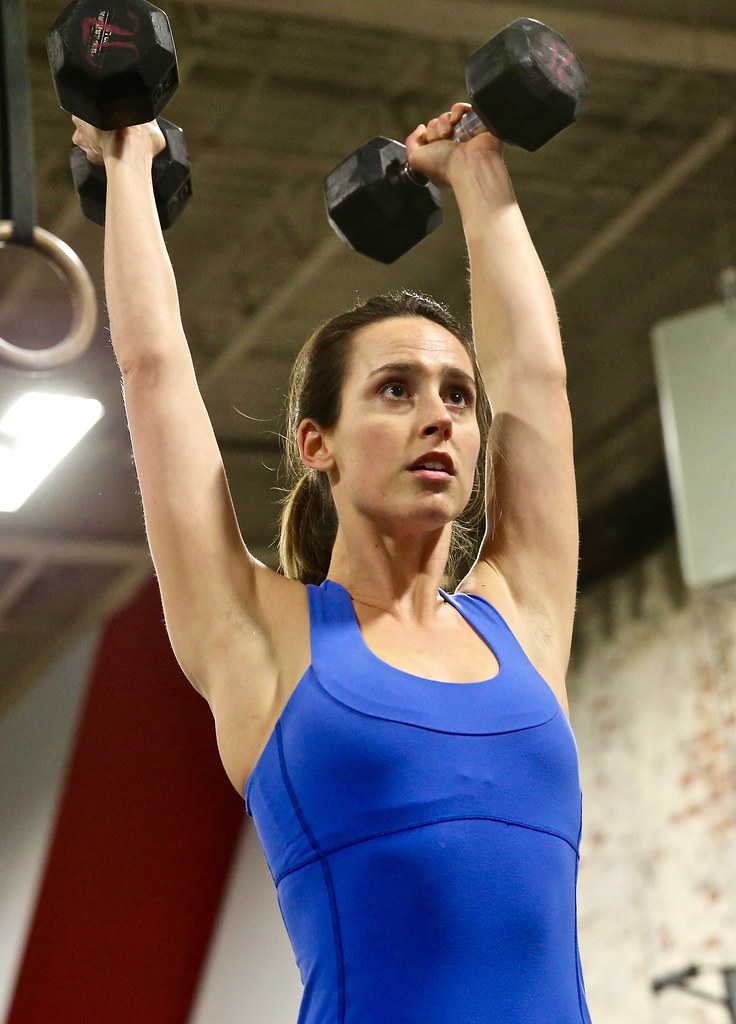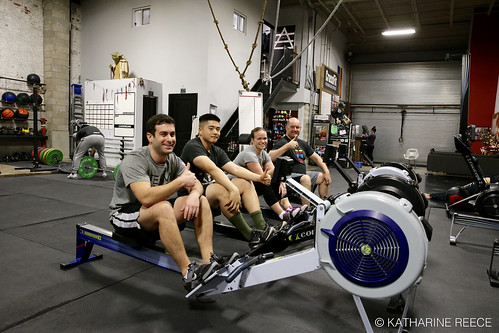
Everyone remembers their first CrossFit workout—but for many people, it was also their last. While some people think of it as a badge of honor that they attempted the “Filthy 50” or “Fran” as their first WOD, many non-conditioned folks are thrown into workout like these and spit out. A person’s first CrossFit workout should be appropriately challenging and leave them with the notion that CrossFit is hard, but also scalable and accessible.
In one of our previous articles, “Free Intro Classes at CrossFit Affiliates,” I discussed the importance of running free intro classes at your affiliate and provided a step-by-step breakdown of what we typically do with folks throughout the entire class. If you missed that article, I recommend you read it over so you understand the intent, tone, and importance of intro classes. In today’s article, we’re going to provide some more examples about reasonable workouts you can use in your own intro classes, and we’ll discuss some concepts to help you write your own workouts.
 Just a note before we get started: I can’t emphasize enough the importance of a free intro class at your CrossFit gym. As most people know, affiliates are cropping up all over the world on an hourly basis, and this class is one of your best opportunities to give potential members a sense of your programming ethos and approach to CrossFit.
Just a note before we get started: I can’t emphasize enough the importance of a free intro class at your CrossFit gym. As most people know, affiliates are cropping up all over the world on an hourly basis, and this class is one of your best opportunities to give potential members a sense of your programming ethos and approach to CrossFit.
There’s a lot of other things that happen in an intro class besides the metcon, which happens after some movement prep and a couplet or triplet warm-up. Before we get into my suggested workouts, below are a few basic questions I ask myself when programming an intro class metcon.
Does this workout provide a reasonable dose of CrossFit?
The workout shouldn’t be so easy that they think CrossFit is no big deal, but it shouldn’t be so hard and intense that it scares off most non-athletic people. To accomplish this, we like to program workouts in the 12-18 minute range and almost always uses AMRAPs. An AMRAP allows athletic people who are moving well to push a little harder while less conditioned folks can go at their own pace until the workout ends. It also gives you a consistent time stamp so that your class structure doesn’t depend on when the last person finishes the workout.
Additionally, shorter workouts in the 2-10 minute range require the person to know how to push the gas pedal hard in order to get a worthwhile stimulus—which most newbies don’t understand yet—while excessively long workouts on the 20-minute-plus end up being unnecessarily high volume for a first exposure to CrossFit and often lead to excessive soreness. Which leads me to my next question…
 Will this workout avoid causing excessive post-workout soreness?
Will this workout avoid causing excessive post-workout soreness?
Regardless of what you do, if someone is deconditioned or not used to doing the movements used in CrossFit, they’re going to get sore. Probably pretty sore. That’s normal, but what’s not normal is writing a workout that can make someone barely able to walk the next day, unable to extend their elbows, or even potentially getting a case of rhabdomyolosis. To avoid this, make sure your workout isn’t a high rep nightmare with lots of eccentric volume. We find it very helpful to include a run or row (single-unders can also work) into the AMRAP, which will preclude some excessive post-workout soreness.
We also try to program AMRAPs that are going to give people about 3-5 rounds of the workout, with most new folks falling in the lower range. This format gives you a predicable amount of volume you’ll put people through, versus a workout like “Cindy”—20 minutes, high volume, lots of eccentric loading—where even a relatively fit person who has never done a ton of volume can easily overdo it. For similar reasons, I also avoid high-rep lunges, jumping pull-ups, and high-rep ring rows.
Does this workout include the following three elements: weightlifting, monostructural, and gymnastics?
One of the best and most recognizable things about CrossFit is its mixed-modal approach to fitness. We try to exemplify this within the workout by making the AMRAP a triplet of three exercises, one from each of the above domains. What you don’t want is for people to confuse CrossFit with bootcamp because you picked a bunch of calisthenics. Make sure it clearly looks and feels like classic CrossFit. This is your chance to show people why CrossFit is awesome!
 For weightlifting, I typically program a dumbbell movement such as a thruster or push press since those movements are easy to teach, accessible to almost anyone, and prevent me from worrying about whether someone’s mobility means they can’t front rack a barbell or keep their back in extension for a pull off the floor. Dumbbell hang power snatches and kettlebell swings are also good weightlifting options.
For weightlifting, I typically program a dumbbell movement such as a thruster or push press since those movements are easy to teach, accessible to almost anyone, and prevent me from worrying about whether someone’s mobility means they can’t front rack a barbell or keep their back in extension for a pull off the floor. Dumbbell hang power snatches and kettlebell swings are also good weightlifting options.
For gymnastics, there’s nothing like a good old burpee to get the job done. These are potent, don’t have a huge eccentric component, and you don’t need a ton of them to get a significant cardiorespiratory response. Burpees also aren’t subject to acute muscular fatigue like a push-up or pull-up. Sit-Ups and low volume air squats could also work.
As we mentioned before, almost any monostructural will work. Just as a side note, if we’re rowing, I always teach it last. It takes the longest to review technique-wise, and I want them to get some practice so that when its time for the workout to start, they’re already on the ergs and ready to go.
A Note About Barbells
While I mention the importance and utility of barbell training in the exit lecture, I don’t ever include it in an intro class. Not only do they require way more time for technique review, they are less accessible for people with mobility issues and require much more troubleshooting with each person, not to mention how much time it can take to find an appropriate weight for the workout per person. In my opinion, most people are apprehensive about barbell training anyway since they’ve never been properly exposed to it and they're not going to get much out of it relative to a dumbbell or kettlebell if its just being used in a metcon.
It should go without saying, but Olympic lifting is ill-advised in an intro class. Once you get people into your Foundations program, then you can start teaching them about the majesty of a barbell, but until then, just give them a good workout with movements they can perform while you walk around and triage movement.

5 Suggested Intro Workouts
Here are a few sample workouts to get an idea of what we think would be a good idea. While many include rowing or running, we also include some that don’t in case equipment or climate restraints make programming those elements impossible.
Quick tip: Be sure to write the workout on the whiteboard because people will typically forget the format!
AMRAP 15:00
Run 200-300 meters or Row 20/15 Cals
15 Dumbbell Push Presses
15 Burpees
AMRAP 16:00
Run or Row 400m
21 Kettlebell Swings or Alternating Dumbbell Hang Power Snatches
12 Burpees
AMRAP 15:00
10 Burpees
15 Kettlebell Swings
20 Calorie Row or 300m Run
AMRAP 14:00
10 Dumbbell Thrusters
20 Sit-Ups
300m Run or Row
AMRAP 15:00
Row 300m or Run 400m
15 Burpees
*this is good for a bigger group or limited space/equipment. Can also easily be tweaked to be an interval style partner workout.
18:00 Partner Workout
9 Box Jumps with step down
9 Burpees
9 Ring Rows or Dumbbell Push Presses
*Partners alternate per round
Common Substitutions
Occasionally people will come to your intro class who are not able to run due to a preexisting ankle or knee issue. For these folks, I suggest seeing if they can substitute a shorter distance and do a brisk walk (fine for less conditioned and older athletes). You can also put them on the rower or assault bike, and in a pinch, sub anchored sit-ups.
Related Links
A CrossFit Coach’s Guide to Working with New or Troubled Movers
Breaking Down Olympic Lifting For New CrossFitters
The Benefits of Introductory Programs at Affiliates
Will Lifting Make Me Bulky? Answers to Common CrossFit Questions
An Open Letter to New CrossFit Coaches
Failing, Bailing, and Training Culture at CrossFit Affiliates
This is What You Need to Know About Choosing the Right CrossFit Gym
Turn Off the Clock: Why You Should Program Not For Time Work at CrossFit Gyms